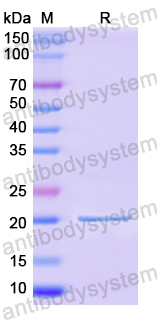Catalog No.
YHG96101
Expression system
E. coli
Species
Homo sapiens (Human)
Protein length
Arg73-Arg237
Predicted molecular weight
20.79 kDa
Nature
Recombinant
Endotoxin level
Please contact with the lab for this information.
Purity
>90% as determined by SDS-PAGE.
Accession
Q14CZ8
Applications
ELISA, Immunogen, SDS-PAGE, WB, Bioactivity testing in progress
Form
Lyophilized
Storage buffer
Lyophilized from a solution in PBS pH 7.4, 0.02% NLS, 1mM EDTA, 4% Trehalose, 1% Mannitol.
Reconstitution
Reconstitute in sterile water for a stock solution. A copy of datasheet will be provided with the products, please refer to it for details.
Shipping
In general, proteins are provided as lyophilized powder/frozen liquid. They are shipped out with dry ice/blue ice unless customers require otherwise.
Stability and Storage
Use a manual defrost freezer and avoid repeated freeze thaw cycles. Store at 2 to 8°C for frequent use. Store at -20 to -80°C for twelve months from the date of receipt.
Alternative Names
HEPACAM, Protein hepaCAM, Hepatocyte cell adhesion molecule
Inflammatory cytokines disrupt astrocyte exosomal HepaCAM-mediated protection against neuronal excitotoxicity in the SOD1G93A ALS model., PMID:39602529
Identification of HEPACAM2 as a novel and specific marker of small cell carcinoma., PMID:39301750
Intragenic homozygous duplication in HEPACAM is associated with megalencephalic leukoencephalopathy with subcortical cysts type 2A., PMID:38280046
Glial Cell Adhesion Molecule (GlialCAM) Determines Proliferative versus Invasive Cell States in Glioblastoma., PMID:37722850
Astroglial exosome HepaCAM signaling and ApoE antagonization coordinates early postnatal cortical pyramidal neuronal axon growth and dendritic spine formation., PMID:37620511
Astroglial exosome HepaCAM signaling and ApoE antagonization coordinates early postnatal cortical pyramidal neuronal axon growth and dendritic spine formation., PMID:36824898
Constructing a molecular subtype model of colon cancer using machine learning., PMID:36188575
HepaCAM‑PIK3CA axis regulates the reprogramming of glutamine metabolism to inhibit prostate cancer cell proliferation., PMID:35191516
Activation of Annexin A2 signaling at the blood-brain barrier in a mouse model of multiple sclerosis., PMID:35064931
A homozygous missense variant in the MLC1 gene underlies megalencephalic leukoencephalopathy with subcortical cysts in large kindred: Heterozygous carriers show seizure and mild motor function deterioration., PMID:34918859
Panobinostat reverses HepaCAM gene expression and suppresses proliferation by increasing histone acetylation in prostate cancer., PMID:34592353
HepaCAM shapes astrocyte territories, stabilizes gap-junction coupling, and influences neuronal excitability., PMID:34352210
HepaCAM controls astrocyte self-organization and coupling., PMID:34171291
STAT3 phosphorylation is required for the HepaCAM-mediated inhibition of castration-resistant prostate cancer cell viability and metastasis., PMID:33909312
Megalencephalic Leukoencephalopathy: Insights Into Pathophysiology and Perspectives for Therapy., PMID:33551753
Cellular basis of ClC-2 Cl- channel-related brain and testis pathologies., PMID:33187987
Long noncoding RNA HOTAIR regulates the invasion and metastasis of prostate cancer by targeting hepaCAM., PMID:33024272
[Analysis of a child with megalencephalic leukoencephalopathy with subcortical cyst type 2B caused by HEPACAM variant]., PMID:32335882
Structural basis for the dominant or recessive character of GLIALCAM mutations found in leukodystrophies., PMID:31960914
Network-guided analysis of hippocampal proteome identifies novel proteins that colocalize with Aβ in a mice model of early-stage Alzheimer's disease., PMID:31494281
Identification in Chinese patients with GLIALCAM mutations of megalencephalic leukoencephalopathy with subcortical cysts and brain pathological study on Glialcam knock-in mouse models., PMID:31372844
HepaCAM inhibits cell proliferation and invasion in prostate cancer by suppressing nuclear translocation of the androgen receptor via its cytoplasmic domain., PMID:30664187
HepaCAM Regulates Warburg Effect of Renal Cell Carcinoma via HIF-1α/NF-κB Signaling Pathway., PMID:30528714
GlialCAM/MLC1 modulates LRRC8/VRAC currents in an indirect manner: Implications for megalencephalic leukoencephalopathy., PMID:30076890
Identification of Critical Genes and Five Prognostic Biomarkers Associated with Colorectal Cancer., PMID:29973580
Megalencephalic leukoencephalopathy with subcortical cysts: Characterization of disease variants., PMID:29661901
HepaCAM inhibits the malignant behavior of castration-resistant prostate cancer cells by downregulating Notch signaling and PF-3084014 (a γ-secretase inhibitor) partly reverses the resistance of refractory prostate cancer to docetaxel and enzalutamide in vitro., PMID:29658567
Megalencephalic leukoencephalopathy with subcortical cysts: A personal biochemical retrospective., PMID:29079544
Overexpression of Hepatocyte Cell Adhesion Molecule (hepaCAM) Inhibits the Proliferation, Migration, and Invasion in Colorectal Cancer Cells., PMID:28244854
Overexpression of HepaCAM inhibits bladder cancer cell proliferation and viability through the AKT/FoxO pathway., PMID:28229220
Interleukin 6 induces cell proliferation of clear cell renal cell carcinoma by suppressing hepaCAM via the STAT3-dependent up-regulation of DNMT1 or DNMT3b., PMID:28093267
HepaCAM associates with connexin 43 and enhances its localization in cellular junctions., PMID:27819278
Megalencephalic leukoencephalopathy with cysts in twelve Egyptian patients: novel mutations in MLC1 and HEPACAM and a founder effect., PMID:27389245
Ten Novel Mutations in Chinese Patients with Megalencephalic Leukoencephalopathy with Subcortical Cysts and a Long-Term Follow-Up Research., PMID:27322623
The SMAD2/3 pathway is involved in hepaCAM-induced apoptosis by inhibiting the nuclear translocation of SMAD2/3 in bladder cancer cells., PMID:26873485
5-azacytidine inhibits the proliferation of bladder cancer cells via reversal of the aberrant hypermethylation of the hepaCAM gene., PMID:26677113
HEPACAM inhibited the growth and migration of cancer cells in the progression of non-small cell lung cancer., PMID:26392113
Leukoencephalopathy associated with 11q24 deletion involving the gene encoding hepatic and glial cell adhesion molecule in two patients., PMID:26193381
Expression of hepaCAM inhibits bladder cancer cell proliferation via a Wnt/β-catenin-dependent pathway in vitro and in vivo., PMID:26192362
Structural determinants of interaction, trafficking and function in the ClC-2/MLC1 subunit GlialCAM involved in leukodystrophy., PMID:26033718
GlialCAM, a glial cell adhesion molecule implicated in neurological disease., PMID:25300132
Identification and characterization of the zebrafish ClC-2 chloride channel orthologs., PMID:25236920
GlialCAM, a CLC-2 Cl(-) channel subunit, activates the slow gate of CLC chloride channels., PMID:25185546
Functional analyses of mutations in HEPACAM causing megalencephalic leukoencephalopathy., PMID:25044933
Megalencephalic leukoencephalopathy with subcortical cysts protein 1 regulates glial surface localization of GLIALCAM from fish to humans., PMID:24824219
Overexpression of HepaCAM inhibits cell viability and motility through suppressing nucleus translocation of androgen receptor and ERK signaling in prostate cancer., PMID:24811146
Renal tumor-derived exosomes inhibit hepaCAM expression of renal carcinoma cells in a p-AKT-dependent manner., PMID:24645843
Autism-epilepsy phenotype with macrocephaly suggests PTEN, but not GLIALCAM, genetic screening., PMID:24580998
HepaCAM inhibits clear cell renal carcinoma 786-0 cell proliferation via blocking PKCε translocation from cytoplasm to plasma membrane., PMID:24515280

